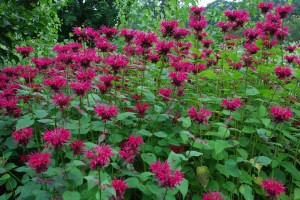Bee balms, aka bergamots or Oswego tea (Monarda spp.) are native to eastern North America (USDA hardiness zones 4-9). Plants are easy to grow, bloom beautifully, and multiply rapidly. They are treasured for their raging colored flowers and medicinal properties. Numerous bee pollinators as well as butterflies and hummingbirds favor the summer blooms.
The native M. didyma produces scarlet red flowers on stems up to six feet tall. New hybrid cultivars are crosses with the shorter M. fistulosa and/or early blooming lavender to pink flowers ofM. bradburiana. The resulting hybrids come in red, violet, purple, pink, and white.
Classic selections such as ‘Gardenview Scarlet’ and ‘Jacob Cline’ continue as standard bearers in the red beebalms. ‘Purple Rooster,’ ‘Raspberry Wine,’ and Grand Parade are rated the best in the purple category. ‘Marshall’s Delight’ (3 ½ feet height) and ‘Pardon My Pink’ (10-12 inch height) are two of the better pinks.
A new Sugar Buzz™ series includes ‘Bubblegum Blast’(hot pink), ‘Cherry Pops’ (cherry red), ‘Grape Gumball’ (vibrant magenta), and ‘Lilac Lollipop’ (lilac). All four cultivars are similar in size, mid-summer bloom time, and vigor. Their 12-15 inch size range fits perfectly into the middle of a flower border. The solid dome flowers sit atop strong, well-branched stems and all display above average resistance to powdery mildew.
Beebalms grow naturally in moist meadows, along rivers and streams, and in forest clearings. Surprisingly, they do grow near black walnut trees. Full sun is best, although plants do thrive in partial sunlight if air movement is adequate. Cutting plant(s) to the ground in late summer will stimulate fresh new growth.
Beebalms should be grown in a well-drained, compost-rich, moderately acidic (pH of 5.5-6.5) soil. They also prosper in containers filled with a porous peat/bark soil-less media mix. Plants are moderate feeders; three bi-monthly feedings of water-soluble fertilizers such as Miracle-Gro™, Nature’s Source™, and Daniels™ is adequate.
Deadhead old flowers for re-bloom a month or so later. Maintain moderate soil moisture levels. Irrigate plants in early morning so as not to encourage, powdery mildew. Aphids, spider mites, thrips, and whiteflies are a few common pests. None are fatal.


 Posted in
Posted in 
